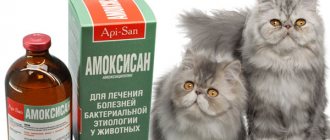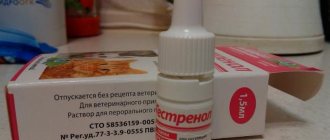6543Pavel
1
Instructions for using the drug Cefazolin for cats will be given to the owner by the veterinarian, who will prescribe this antibiotic to treat the pet. This is a 1st generation antibiotic drug that has the widest possible spectrum of action and allows you to combat many cat health problems. The substance is active against gram-positive bacteria. Cefazolin does not act on a number of strains of Proteus, as well as fungi, protozoa and rickettsia. Like all antibiotics, Cefazolin for cats cannot be used to fight viral infections.
Review of the use of the antibacterial agent cefazolin in small animals
Cefazolin is an antibiotic commonly known as Kefzol® and Ancef®
, a class of first-generation cephalosporins. The mechanism of action of cephalosporins is similar to that of penicillins, but cephalosporins have a much broader spectrum of action against bacteria than penicillins.
Cefazolin is used in small pets to treat a variety of bacterial infections, including skin infections, wound infections, bone infections, pneumonia, and bladder infections.
Cefazolin in animals
will prevent bacteria from forming an adequate and strong cell wall. This leads to instability and subsequent death of bacteria.
Cefazolin is a prescription drug and can only be obtained at a veterinary clinic or with a prescription from a veterinarian. This drug is not FDA approved for use in animals, but veterinarians legally prescribe it as an over-the-counter drug.
Adverse reactions
When Cefazolin is used correctly, therapy proceeds well and does not provoke negative effects. But occasionally, in particular, if a cat is personally intolerant to an antibiotic, the following side effects may develop:
Animal intolerance to the drug may manifest itself in the form of body itching.
- Quincke's edema;
- nausea, urge to vomit;
- frequent loose stools;
- urticaria, itching of the skin;
- feverish condition;
- anaphylactic shock;
- deterioration of kidney function;
- pain at the injection site.
Precautions and side effects
Although this medication is generally safe and effective when prescribed by a veterinarian, cefazolin may cause side effects in some animals.
Cefazolin should not be used in animals with known hypersensitivity or allergy to the drug.
If the pet is already sensitive to allergies or vomiting from other cephalosporin (cefadroxil) or penicillin (amoxicillin, ampicillin) drugs, cross-reaction with cefazolin is possible. Cefazolin may interact with other medicines. Check with your veterinarian to determine if other medications your pet is receiving may interact with cefazolin. Such drugs include some other antibiotics.
The most common side effect in veterinary medicine is vomiting shortly after administration. This is not usually a sign of serious illness, but does indicate that the animal is sensitive to this drug. It is not uncommon for some animals to develop diarrhea from orally administered antibiotics such as cefazolin. However, this was not a common complaint with cefazolin.
Pharmacokinetics of Cefazolin
Cefazolin is administered to cats in diluted form. It is sold in the form of a medicinal powder, from which a suspension for administration is prepared. An hour after the injection, the concentration of the substance in the blood plasma becomes maximum and remains in the cat’s body for 12 hours. A full description of the effect of the antibiotic on the animal can be found in the instructions, but it is more required by veterinarians than by owners.
Cefazolin is excreted by the kidneys. The composition is removed from the body unchanged. Due to its ability to penetrate into milk and through the placenta to kittens, the product is not used for pregnant and lactating cats unless absolutely necessary.
Cefazolin dosage information in veterinary medicine
Medications should never be administered without first consulting a veterinarian. In animals, the usual dose of cefazolin is 10 to 30 mg/kg every 6 to 8 hours intramuscularly or intravenously. After taking the drug, many pets are sent home with a prescription for an oral cephalosporin, such as cefadroxil or cephalexin.
The duration of administration depends on the condition being treated, response to treatment, and development of side effects. Be sure to complete the course of therapy unless specifically directed by your veterinarian. Even if your pet feels better, the entire treatment plan must be completed to prevent relapse or prevent the development of resistance.
How to administer Cefazolin to a cat
Before administration, Cefazolin powder must be dissolved in sterile water for injection, novocaine or lidocaine. The therapeutic effect of the drug will not change, but when diluted with anesthetics, the discomfort that the animal will experience during the procedure is significantly reduced. To dilute 1 g of powder, you will need 5 ml of liquid - 0.5-1% novocaine solution, sterile water for injection or 0.9% sodium chloride solution. It is not recommended to dilute Cefazolin with lidocaine when treating cats - it causes serious allergic reactions in animals, and also negatively affects the functioning of the cardiovascular system and blood pressure.
- Draw 5 ml of liquid into the syringe, remove the protective aluminum cap of the bottle with powder.
- Pierce the rubber cap, add liquid into the bottle, then shake it vigorously several times so that the components are well mixed - you should get a homogeneous transparent solution, possibly with a slight sediment.
- Change the needle, open the bottle cap and draw the required amount of medicine into the syringe, then administer it to your pet.
Before administration, Cefazolin must be diluted with special water or anesthetic
The resulting solution should be used as soon as possible - it can be stored in the refrigerator for no more than 2 days (leaving the medicine at room temperature is prohibited).
The dosage and schedule of administration of Cefazolin is determined solely by the doctor - the average dosage of the active substance for cats is 15 mg per kilogram of weight, but in severe conditions the amount can be increased to 30 mg. Injections are given at intervals of 6-12 hours, the course of treatment depends on the clinical course of the disease and the condition of the animal, on average it lasts 5-10 days. When using the drug for prophylactic purposes to prevent postoperative complications, it is administered for no more than 3-5 days.
For reference! For intravenous administration, Cefazolin is diluted exclusively in saline solution (sodium chloride), but such a procedure should only be carried out by a medical professional in a hospital setting.
Learn about essential antimicrobials in animals
- Trichopolum for animals
- Instructions for the use of baytril in veterinary medicine
- Metronide for animals (instructions for use, doses, indications and contraindications)
- Instructions for the use of ceftriaxone in veterinary medicine (Ceftriaxone). Explore the breadth of the antibacterial effect of ceftriaxone in animals
- Explore the breadth of Metrogyl's antibacterial effect in animals
- Instructions for the use of doxycycline in animals. Study the breadth of doxycycline's antibacterial effects in animals. Calculate the optimal dose of the drug for different types. Improve therapy effectiveness by 140%
- Metronidazole (Metronidazole) for animals (instructions for use in veterinary medicine, doses, indications and contraindications)
- Atovaquone for animals
- Azithromycin for animals
^Top
Indications for use of Cefazolin for cats
The antibiotic is used quite widely in veterinary practice, although there are also analogues of this drug. The main indications for administering Cefazolin to a cat are :
- pneumonia;
- inflammation of the pleura;
- lung abscess;
- peritonitis;
- infected wounds;
- purulent inflammation of bones and joints;
- inflammatory diseases of the urinary system caused by bacteria sensitive to Cefazolin;
- postoperative complications.
It is strictly not recommended to prescribe Cefazolin to a cat or dog on your own. This can lead to very serious consequences for the health of the animal, and in rare cases even cause death. Antibiotics are rarely used for kittens. Before using the drug Cefazolin, consultation with a veterinarian is required.
Instructions
- Russian
- Kazakh
Tradename
International nonproprietary name
Dosage form
Powder for the preparation of solution for intravenous and intramuscular administration, 1 g
Compound
One bottle contains
active substance – cefazolin sodium (in terms of cefazolin) 1.0 g
Description
Powder of white or white with a yellowish tint
Pharmacotherapeutic group
Antibacterial drugs for systemic use. Other beta-lactam antibacterial drugs. First generation cephalosporins. Cefazolin
ATX code J01DВ04
Pharmacological properties
Pharmacokinetics
The time to reach maximum concentration (TCmax) with intramuscular administration at a dose of 1 g is 1 hour; maximum concentration (Cmax) –64 µg/ml; after intravenous administration of TCmax - at the end of the infusion, after intravenous administration of 1 g Cmax - 180 μg/ml. Penetrates into joints, tissues of the cardiovascular system, abdominal cavity, kidneys and urinary tract, placenta, middle ear, respiratory tract, skin and soft tissues. Excreted in small quantities into breast milk. Concentrations in gallbladder tissue and bile are significantly higher than in blood serum. With gallbladder obstruction, the concentration in bile is less than in plasma. Volume of distribution – 0.12 l/kg. Connection with plasma proteins – 85%. The half-life (T1/2) with intramuscular administration is 1.8 hours, with intravenous administration - 2 hours. In case of impaired renal function, T1/2 is 20-40 hours.
It is excreted mainly by the kidneys unchanged: during the first 6 hours - 60-90%, after 24 hours - 70-95%. After intramuscular administration at a dose of 1 g, Cmax in urine is 4 mg/ml.
Pharmacodynamics
Cefazolin-AKOS is a first generation cephalosporin antibiotic for parenteral use. It acts bactericidal, disrupting the synthesis of the cell wall of microorganisms. It has a wide spectrum of action, is active against gram-positive (Staphylococcus spp., Staphylococcus aureus (non-producing and producing penicillinase; including Streptococcus pneumoniae), Corynebacterium diphtheriae, Bacillus anthracis) and gram-negative (Neisseria meningitidis, Neisseria gonorrhoeae, Shigella spp., Salmonella spp., Escherichia coli, Klebsiella spp., Treponema spp., Leptospira spp.) microorganisms. Active against Haemophilus influenzae, some strains of Enterobacter spp. and Enterococcus spp.
special instructions
Patients with a history of allergic reactions to penicillins or carbapenems may have increased sensitivity to cephalosporin antibiotics.
During treatment with cefazolin, it is possible to obtain positive direct and indirect Coombs tests, as well as a false positive urine reaction to sugar.
When prescribing the drug, exacerbation of gastrointestinal diseases, especially colitis, is possible.
When thawed, the solution remains stable for 10 days when stored in a refrigerator (5 degrees C) or 48 hours at room temperature.
The safety of use in premature infants and children in the first year of life has not been established.
Side effects
Allergic reactions: hyperthermia, skin rash, urticaria, itching, bronchospasm, eosinophilia, angioedema, arthralgia, anaphylactic shock, exudative erythema multiforme (including Stevens-Johnson syndrome).
From the nervous system: convulsions.
From the urinary system: in patients with kidney diseases, when treated with large doses (6 g), there is impaired renal function (in these cases, the dose is reduced and treatment is carried out under the control of the dynamics of the concentration of urea nitrogen and creatinine in the blood).
From the digestive system: nausea, vomiting, diarrhea, abdominal pain, pseudomembranous enterocolitis, rarely - cholestatic jaundice, hepatitis.
From the hematopoietic organs: leukopenia, neutropenia, thrombocytopenia, thrombocytosis, hemolytic anemia.
With long-term treatment - dysbacteriosis, superinfection caused by antibiotic-resistant strains, candidiasis (including candidal stomatitis).
Laboratory indicators: positive Coombs test, increased activity of “liver” transaminases, hypercreatininemia, increased prothrombin time.
Local reactions: with intramuscular injection - pain (at the injection site), with intravenous injection - phlebitis.











